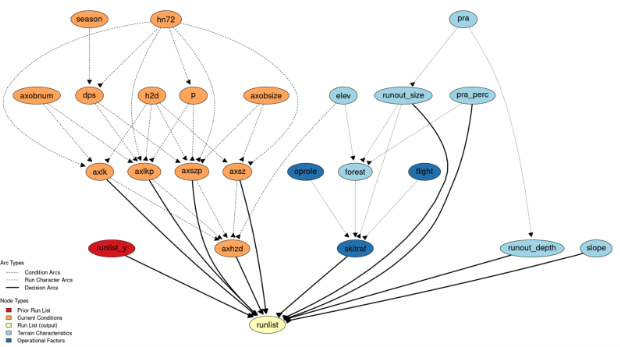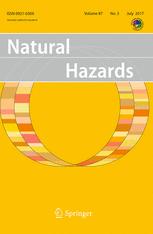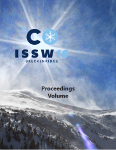
Project Overview
Professional ski guides have developed standard practices for decision-making in a complex and dynamic environment over decades of experience. This project aims to better understand existing decision-making practices of Canadian mechanize guiding operations and apply cutting edge avalanche terrain modelling, GPS tracking, and machine learning approaches to model their real-world decisions. The main focuses of this project are to quantitively characterize the avalanche terrain at mechanized guiding operations by applying state of the art avalanche terrain mapping techniques and to develop statistical models to capture specific decision-making processes. The existing research focuses on how guides decide when to open and close specific runs within their tenure, which is the first step in a hierarchical decision-making process. Future research could home in on slope scale or terrain features scale decisions using GPS tracking data collected from mechanized guiding operations across Western Canada.
Understanding the terrain guides operate in is the foundation for understanding their decision-making process. To effectively characterize avalanche terrain, we developed a high-resolution digital elevation model and forest cover model using satellite imagery analysis for a test site covering the tenure of Canadian Mountain Holidays Galena Lodge, located south of Revelstoke, BC in the Selkirk Mountains. Using the high-resolution elevation and forest cover data, we worked with expert guides to calibrate avalanche release area and runout models to capture the avalanche hazard exposure across the guiding tenure. By combining the avalanche terrain models with GPS tracking data, we used clustering analysis to identify specific common routes within each run of the guiding tenure and characterized the avalanche hazard exposure for each route. This detailed spatial analysis specifically characterizes the terrain that guides are travelling in daily and aims to capture the terrain characteristics in a way that reflects the guides perspective.
To realistically capture the breadth of factors that contribute to guides’ decision-making we worked closely with experienced guides to build decision-making models of their morning run list process. Where guides code runs as ‘open’, ‘closed’, or ‘not considered’ for the day from a predefined list of roughly 300 runs. This is the first step in a chain of decisions that determine the avalanche risk exposure for a given day. The models used data from the guiding operation, collected over seven winter seasons, to characterize weather, avalanche, and operational factors relevant for the decision-making process. We compared multiple machine learning approaches to model this decision-making process. Which resulted in predictive accuracies ranging from roughly 85% to 93%. These models are intended to support guides decision-making practices by providing quantitative assessments of current conditions based on historic decisions from the guiding operation. While this specific case study at CMH Galena yielded models with high predictive accuracy and seems to realistically captures the run list decision-making process, further work is necessary to integrate this type of decision support tool with guides in the real world.
Involved Researchers
- John Sykes
- Reto Sterchi
- Pascal Haegeli
- Roger Atkins (Canadian Mountain Holidays, Revelstoke, BC, Canada)
- Patrick Mair (Department of Psychology, Harvard University, Cambridge, MA, USA)
- Yves Bühler (WSL Institute for Snow and Avalanche Research SLF, Davos, Switzerland) Partner organizations
Partner Organizations
Project Funding
Relevant Publications

Development of operational decision support tools for mechanized ski guiding using avalanche terrain modelling, GPS tracking, and machine learning

Quantitatively capturing decision-making practices of mechanized ski guides using GPS tracking, avalanche terrain modelling and Bayesian Networks

Automated snow avalanche release area delineation in data sparse, remote, and forested regions

Exploring the relationship between avalanche hazard and run list terrain choices at a helicopter skiing operation

Patterns in the exposure of ski guides to avalanche terrain

What type of ski runs are acceptable for skiing under different avalanche hazard conditions? Extracting knowledge from heli-ski guides

A method of deriving operation-specific ski run classes for avalanche risk management decisions in mechanized skiing

Describing the severity of avalanche terrain numerically using the observed terrain selection practices of professional guides


